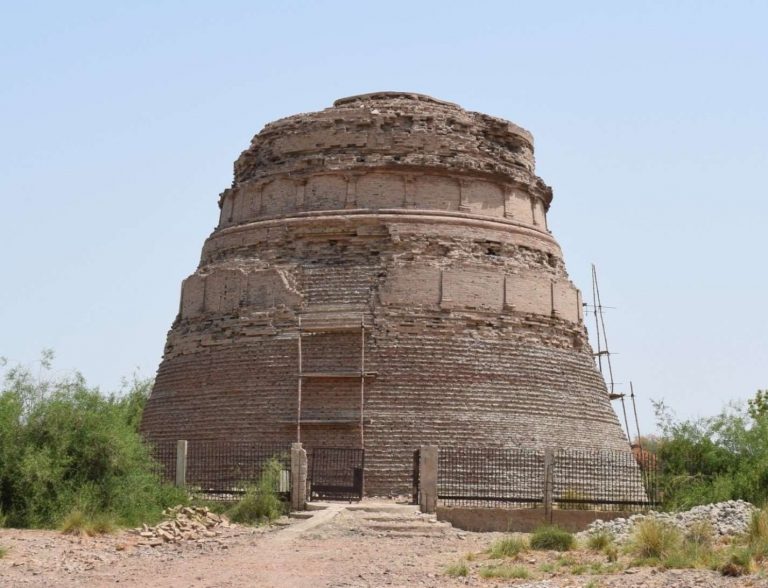
Sindh Antiquities Department had started the conservation work but stopped due to lack of budget and other reasons. The bricks used in conservation work were different to old material.
It is said that small numbers of Buddhist community are still residing in District Naushehro Feroze.
Zahoor Dahri
History of Buddhism
The History of Buddhism, which dates back to 6th century BCE, spread in the eastern part of Ancient India, in and around the ancient Kingdom of Magadha (now in Bihar, India), and is based on the teachings of Siddhārtha Gautama. This makes it one of the oldest faiths practiced today. The Buddhism spread from the northeastern region of the Indian subcontinent and the Central, East, and Southeast Asia. At one time or another, it influenced most of the Asian continent. The history of Buddhism is also characterized by the development of numerous movements, schisms, and schools, among them the Theravāda, Mahāyāna, and Vajrayāna traditions, with contrasting periods of expansion and retreat.
This faith widely spread during King Ashoka’s reign in 272 BC. He built many Buddhist monasteries, charities, and stupas. In the areas that now make Pakistan, it took root some 2,300 years ago under the Mauryan King Ashoka, whom Nehru once called “greater than any king or emperor. It emerged in Sindh after Hinduism when people were sick of caste systems. It’s following in the region dropped gradually after emergence of Islam in the 8th century.
The decline of Buddhism has been attributed to various factors, especially the regionalization of India after the end of the Gupta Empire (320–650 CE). Another factor was the invasions of Muslims in Sindh due to the Buddhist population converted to Islam and other religions and the remaining migrated to other countries. The total Buddhist population in 2010 in the Indian subcontinent – excluding that of Sri Lanka, Nepal and Bhutan – was about 10 million, of which about 7.2% lived in Bangladesh, 92.5% in India and 0.2% in Pakistan.

Buddhism in Pakistan
After the inception of Pakistan, it started disappearing from Sindh also and like many other minority groups living in Pakistan such as Bahai’s, Hindus, Parsi, Ahmadis, Christians, etc. the Buddhism is also a minority group in Sindh. People believe that Buddhists don’t exist in Sindh. They are forgotten and their presence is neglectful. There is quite a little scholarship on the living Buddhists in Sindh. But a recent short documentary by BBC (2018) and the Ph.D. thesis of Dr. Bukhari (2011) prove that there still are some Buddhist communities’ living and practicing in Sindh.

The only functional Buddhist temple in Pakistan is in the Diplomatic Enclave at Islamabad, used by Buddhist diplomats from countries like Sri Lanka. The majority of people in Gandhara, present-day Khyber Pakhtunkhwa province, were Buddhist. Gandhara was largely Mahayana Buddhist, but also a stronghold of Vajrayana Buddhism. The Swat Valley, known in antiquity as Uddiyana, was a kingdom tributary to Gandhara.
In Sindh today the major focus of researchers, archaeologists and anthropologists is on how to preserve the archaeological Buddhist sites, stupa and statutes found from Sindh, but they never know about the Buddhists living in Sindh and are endangered. It is said that small numbers of Buddhist community are still residing in District Naushehro Feroze though they don’t have the way of religious exercises as the Buddhists have but they are known as Buddhists.
There are many archaeological sites of the Buddhist era in Swat. Most Buddhists in Punjab, Khyber Pakhtunkhwa, and Sindh were in process of converting to Hinduism from 600 A.D onwards. Buddhism was practiced by the majority of the population of Sindh up to the Arab conquest by the Umayyad Caliphate in 710 A.D.

Buddhist Stupas in Sindh
In Sindh too there are several archaeological sites of Buddhist era. One of them is the site of Miyan Rukan jo Thul (Stupa) located in village Thul at a distance of about 22km southwest of Bandhi railway station and 13 km southeast of the Daulatpur town in Taluka Qazi Ahmed, District Shaheed Benazir Abad (Formerly Nawabshah). The other known Stupas in Sindh are Stupa of Mohen-jo- Daro in Larkana, Kahu jo Daro in Mirpurkhas, Sudhern jo Daro in Tando Muhammad Khan, Maroo Thul in Dadu and some others.


Stupas were built by the king of Ashoka, Grandson of Chandragupta Maurya, when he ordered to build 84000 stupas in his kingdom. It was the golden age of Buddhism in Sindh.
The followers of Buddhism used to worship Buddha in the Stupa. The Stupa, discussed here, was first time surveyed by archeologist Henry Cousens in 1909-10 A.D. who found Buddha’s statue(Henry’s book: The Antiquities of Sind, with historical outline. 184 p. 102 pl. Calcutta 1929). The burned-brick structure of stupa is part of cultural heritage of Sindh.


This stupa is a single cylindrical structural shape that has different designs depicted on brunt bricks like geometrical, flower, motive, cut –brick, net design patterns and also used penal at the upper part of the stupa. The stupa has been divided into three portions and no window and door are discovered here. The same types of stupa were also found in Swat.
The stupa is divided into three portions according to architectural elements. This is decorated with motive and geometrical pattern penal. The lower part of the stupa was decorated with penal having a motive design around the stupa and the center has the same design but the penal is reduced when going on height. Same is in the final portion of the stupa. The circumference of the stupa is 105’.5’’ and the height of the stupa is 66 feet.
Conservation Work
The stupa was restored recently in 2017 under the Sindh government’s antiquities department. The burnt bricks and mud were used as mortar in the restoration work. The different sizes of bricks have been used in different components of the stupa. The bricks were laid with a very thin mortar and the outside surface of the stupa has been protected from the elements with thick plaster. Bricks were used for the foundation as well, with special precautions taken to prevent the ingress of moisture.


The raw material used for rehabilitation were brought from nearby towns of Daulatpur, Qazi Ahmad, and Nawabshah. The burnt-bricks came from a nearby Batho (Kiln). The bricks used in conservation work were different to old material while mud mortar was made at the site and used in conservation work. Unfortunately, work was stopped due to short budget.
Professor Irshad Ali Otho, Professor at Government Degree Collage Daulatpur, who, according to him, supervised the rehabilitation work, and was also the focal person of Sindh government, told that the work was stopped due to some issues, and hoped that work will be started again soon.
______________
 The Author is an Archaeological Conservator at the Tomb of Mian Noor Muhammad Kalhoro Complex Shaheed Benazir Abad. He can be contacted at: Zali59191@gmail.com
The Author is an Archaeological Conservator at the Tomb of Mian Noor Muhammad Kalhoro Complex Shaheed Benazir Abad. He can be contacted at: Zali59191@gmail.com